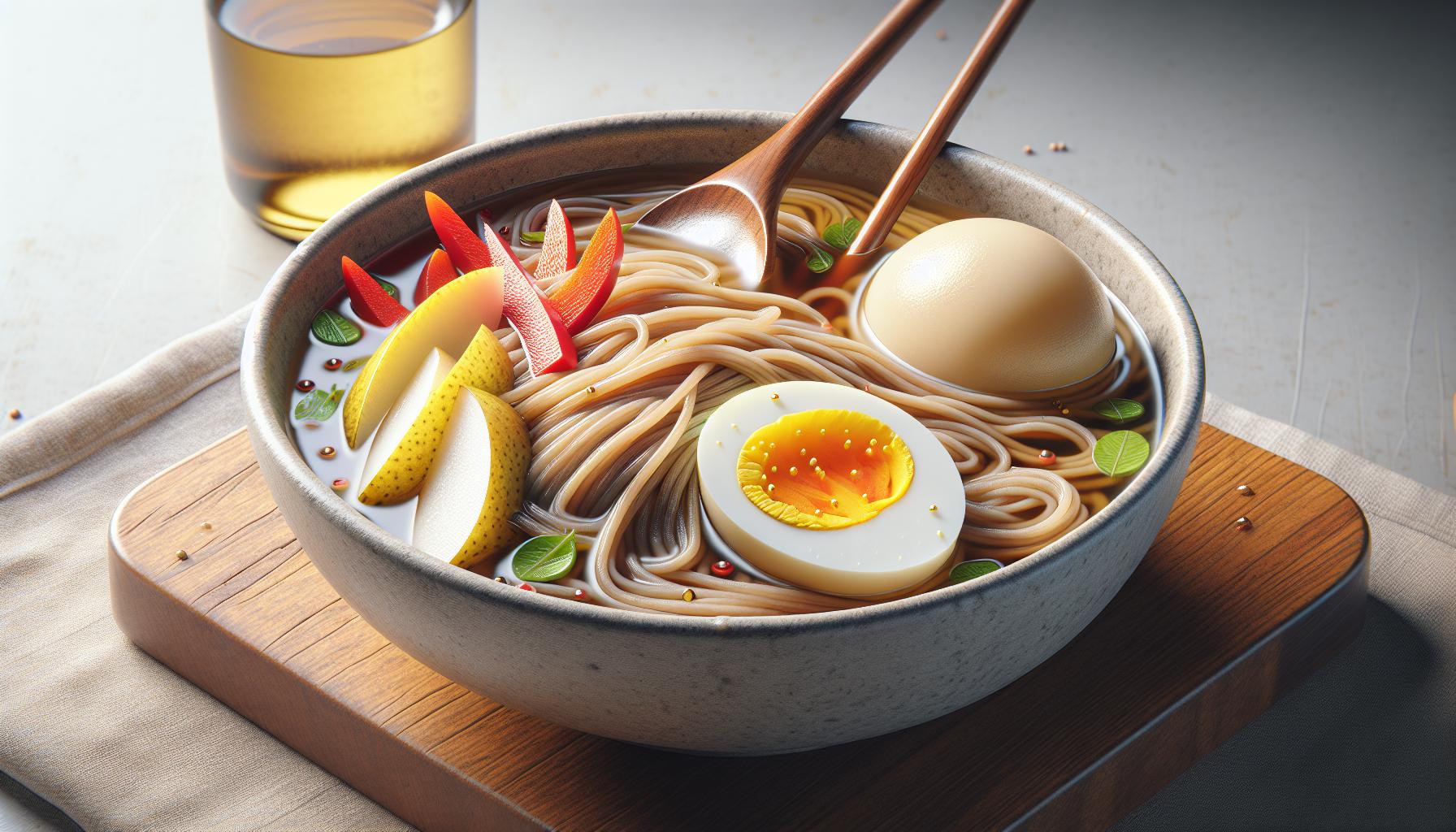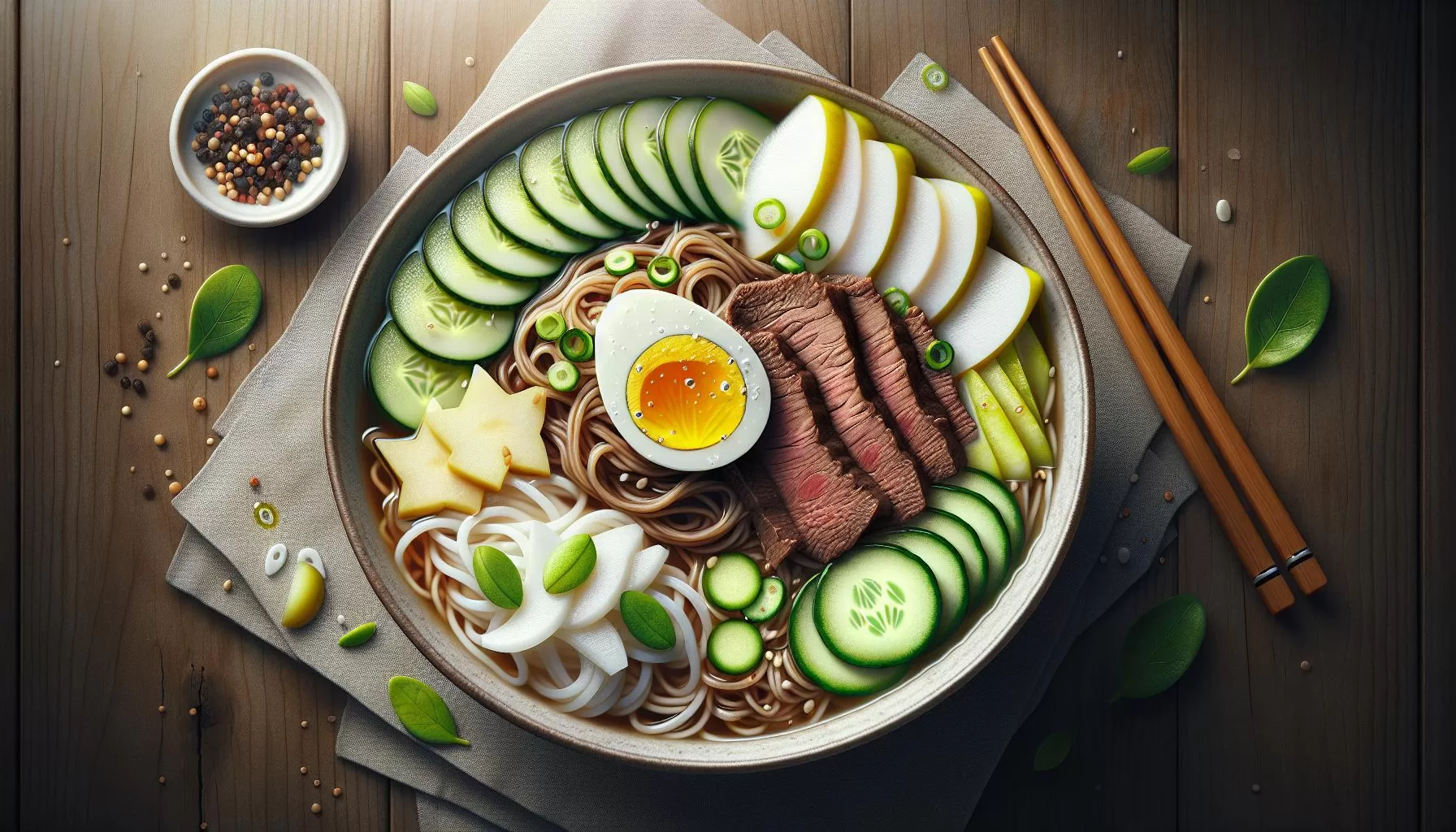Ingredients for Homemade Naengmyeon Cold Noodles
To create your refreshing cold noodle dish, you will need:
- 500g of buckwheat noodles: Naengmyeon tradition calls for chewy, thin buckwheat noodles. If unavailable, soba noodles make a good alternative.
- 200g of beef brisket: Boiled and thinly sliced. Beef enhances the savory depth of your broth.
- 4 cups of water: To cook the noodles and create a broth base.
- 1 Korean pear: Sweet and crisp, this pear adds delightful freshness to your dish.
- 4 eggs: Hard-boiled to perfection, the eggs add texture and protein.
Your naengmyeon recipe will take a delightful turn with these unique ingredients:
- Mustard oil: A teaspoon of mustard oil brings a swirling heat that complements the cold noodles.
- 1 Red bell pepper: Thinly sliced bell pepper adds a crunchy element and vibrant color.
For a nutrient-rich broth, you’ll use:
- 1 kelp strip, 10 dried anchovies: These ingredients amplify the umami flavor in your broth.
- 4 cloves of garlic, 1 onion: Essential for crafting a deeply flavorful broth.
| Ingredients | Nutritional Value (per 100g) |
|---|---|
| Buckwheat noodles | Calories – 336, Carbs – 71g, Protein – 13g |
| Beef brisket | Calories – 271, Protein – 26g, Fat – 18g |
| Korean pear | Calories – 57, Carbs – 15g, Vitamin C – 3.1mg |
| Eggs | Calories – 68, Protein – 6g, Fat – 4.5g |
Remember, freshness is key in this delightful cold noodle recipe. While there are unique additions to explore in this recipe, the nucleus remains the same: high-quality ingredients delivering the traditional flavor of Naengmyeon. Now, with ingredients at hand, let’s move forward to learn the interesting cooking steps.
Step-by-Step Instructions

Let’s dive right into the cooking process of making your own naengmyeon. Trust us, it’s simpler than you’d think.
Step One: Prepare the Broth
Start with the broth, the soul of naengmyeon. Place your beef brisket in a pot, fill it with water and bring it to a boil. You’ll want about 2 to 3 cups of water for a medium-sized piece of brisket. Once it’s boiling, lower the heat and let it simmer. As it simmers, gently skim off any impurities or foam that floats to the top. Your aim is a clear, flavorful broth.
To enhance the broth, add the kelp strip, dried anchovies, garlic, and onion to the pot. Let it further simmer for about an hour.
Step Two: Prepare the Noodles
While your broth simmers, take this time to prepare the buckwheat noodles. You’ll want about 100g of noodles per serving. Follow the instructions on the packet for best results.
Hint: To ensure your noodles are perfectly cooked, once boiled, run them under cold water. This stops the cooking process, keeping them firm and chewy.
Step Three: Prepare the Garnish
Preparing the garnish is all about giving the dish visual appeal and an extra texture. Take your Korean pear, red bell pepper and hard-boiled eggs and slice them thinly. Remember, presentation matters.
Step Four: Assemble Your Dish
Finally, with all components ready, it’s time to assemble your dish. Place your cooled, drained noodles in a large bowl. Arrange your garnishes neatly on top. Then, pour your strained, chilled broth over the top. Drizzle with a little mustard oil for an extra kick if you like.
Voila! Your homemade naengmyeon is ready to be savored. By now, you can appreciate the delicate balance of flavors that make this dish so beloved in Korean cuisine. It’s truly a refreshing, invigorating dish that you’ll eagerly revisit time and again.
Oh, and don’t forget, if you’re interested, you can always dive deeper into the nutritional value of the dish. Each ingredient brings its own benefits, from the low-calorie buckwheat noodles to the protein-packed eggs.
Tips for Making the Perfect Naengmyeon

Perfecting the art of Naengmyeon in your own kitchen can be a rewarding endeavor. When you’re getting ready to create this delicious, refreshing dish, consider these key tips.
Quality ingredients: Top-notch ingredients make a significant difference. Fresh buckwheat noodles, dried anchovies, and kelp strip will notably elevate your dish.
Broth preparation: You have to prepare the broth correctly—it’s the soul of the dish. Take time and simmer it slowly up to two hours for a clear, flavorful broth. Avoid rushing the process, it’s important that the brisket is tender and the flavor deeply developed.
Balancing Flavors: Striking a delicate balance between flavors is crucial in Korean cuisine. With Naengmyeon, it’s crucial to calibrate the sweet, salty, and tangy notes in your broth.
Unusual Ingredients: For an extra kick, substitute the kelp with dashi kombu. It’s a bold move that can create a subtly different, yet equally refreshing taste.
Naengmyeon’s Nutritional Value:
If you’re interested in the nutritional value, here’s a quick overview.
| Nutritional Information | Per serving |
|---|---|
| Calories | 400 |
| Carbs | 50g |
| Protein | 30g |
| Fat | 10g |
Remember Naengmyeon is not just about the taste; it’s also packed with nutrients. Making your homemade Naengmyeon allows you to control the ingredients and keep the great flavor while upping the nutritional value. It truly embodies the essence of Korean cuisine—an ingenious combination of taste, texture, and health benefits.
Enjoy exploring and adjusting to your preference. The magic of cooking lies in personalization. So, get your utensils ready and start creating.
Serving and Presentation

You’ve perfected your broth, boiled your buckwheat noodles, and prepped your toppings. Now, let’s move onto the final stage, serving and presenting your homemade Naengmyeon. As in any dish, presentation matters. It’s the first impression on the dining table. Making your Naengmyeon look inviting is just as important as hitting those perfect, balanced flavors.
Start off by chilling your serving bowls for a few minutes before plating up. Nothing beats a bowl of Naengmyeon served cold, amping up the refreshing taste better this way. Next, portion out your noodles evenly among the bowls. Pour over that golden, clear broth you’ve painstakingly simmered for hours. The more aromatic, clear broth you add, the more it’ll enrich the taste and bring out those tangy, umami flavors.
You’ve got your toppings ready, haven’t you? Top up your noodles with slices of cool, boiled beef, crisp cucumber slices, Korean pear, and a boiled egg cut into half. The beef adds a hearty feel to the dish. Cucumbers bring a crunchy texture and pop of color. The Korean pear lends a unique sweet-tangy flavor, while the egg contributes creamy richness. Arrange them so they look as good as they taste.
However, don’t stagnate with just these suggestions. Feel free to add your favorite toppings. From pickled radish to shredded carrots, chopped green onions, or even a dollop of spicy gochujang sauce for heat-seekers, personalize your Naengmyeon to your liking.
Remember that Korean cuisine highly values balance – not just of flavors, but also in presentation and nutritional value. A bowl of homemade Naengmyeon ticks all these boxes. A single serving usually contains a balance of calories, carbs, protein, and fat. Here’s a handy table:
| Nutrition | Amount per serving |
|---|---|
| Calories | 550 |
| Carbs | 95g |
| Protein | 20g |
| Fat | 15g |
Health Benefits of Naengmyeon

While your homemade Naengmyeon is sure to impress with its delightful mix of flavors, it’s not just a treat for your palate. It also offers an array of health benefits. The ingredients used aren’t merely for taste – they contribute significantly to your wellness too.
One of the main components of Naengmyeon, buckwheat noodles, are a rich source of nutrients. They are packed with dietary fiber, essential amino acids, minerals like manganese and copper, and vitamins like the B-complex group.
| Nutrient | Amount |
|---|---|
| Dietary Fiber | 6g |
| Essential Amino Acids | 2.5g |
| Manganese | 1.3mg |
| Copper | 0.3mg |
| B-complex Vitamins | 1.3mg |
Let’s delve into the health benefits of buckwheat noodles. Besides being a source of energy and protein, they contribute to heart health, help control diabetes, and assist in digestive health.
The broth in Naengmyeon is no less a superstar when it comes to health. The slow-cooked, simmered bone broth contributes a significant amount of calcium, collagen, and other nutrients. If you load up your bowl with a variety of toppings, you’re adding to the overall nutritional value.
And did you know, cucumber offers hydration and Korean pear aids in digestion while also providing a source of Vitamin C? A mixture of these and other toppings provide a great source of diverse vitamins and minerals to make your Naengmyeon a well-rounded meal.
That’s just the beginning. The flexibility of this dish allows you to add as many nutritious ingredients as you want! If you want to go for a protein-rich version, add more boiled eggs or beef. Prefer more vitamins and taste? Add pickled radish or gochujang sauce.
Conclusion
You’ve now discovered the power-packed health benefits of homemade Naengmyeon. It’s not just about the taste, but also the nutritional value you can derive from this delightful dish. With buckwheat noodles as the base, you’re getting a good dose of fiber, amino acids, minerals, and B-complex vitamins. The broth brings in calcium and collagen, while toppings like cucumber and Korean pear hydrate and aid digestion. Remember, you can always add your own twist with nutritious ingredients like boiled eggs, beef, or pickled radish. So, the next time you’re looking for a healthy and satisfying meal, don’t forget to consider Naengmyeon. It’s a complete meal that’s as flexible as it is nutritious.

